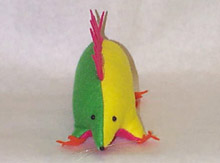Neon By Adam Pounds |
|
| The term mole is used to indicate the quantity of a substance that has a mass in grams numerically equal to its molecular mass. This mass contains Avogadro’s number of molecules. The element Neon is in a group of elements called the Noble Gases. They arer called Noble Gases because they do not tend to react with any other elements. They are "Above" all of the other elements. Elements react because hey want to gain electrons or lose electrons. The most electron that an atom can have in the outermost energy level is 8. This is called a stable octet. Noble gases already have eight valence electrons. They have no need to gain or lose any so they do not react at all. Neon’s elemental symbol is Ne. It has an atomic number is 10. Neon has an atomic weight of 20.183. Neon is a chemical element that makes up 18 parts per million in the earth’s atmosphere. The British scientists Sir William Ramsay and Morris W. Travers discovered it in the atmosphere while they were studying liquid air in 1898. Ramsay and Travers named this element Neon, which means "New" in the Greek language. We have found many uses for the element Neon. Neon is chiefly used for filling lamps and luminous sign tubes. Its usual color in lamps is a bright red shade. Many airplane beacons use neon lights because it can penetrate the heavy fog. In some instances pilots have reported seeing the neon lights from over 20 miles away. The steps the individual atoms of Neon go through to give off light are surprisingly simple. Electricity passing through the gas knocks of electrons from the valence shell. When the electron flies back into the orbit from which it came, energy in the form of a bright red light is released. This light energy is the source of the tube’s glow. The individual rays of light flying off of the atom are what the human eye sees. Another use for Neon is an economical cryogenic refrigerant. It has over 40 times more refrigerating capacity per unit volume than liquid helium and more than 3 times that of liquid hydrogen. It is inert, compact, and less expensive than helium when it meets refrigeration requirements. Neon is an extremely inert element. It forms an unstable hydrate. Neon is a colorless odorless gas. Of all the ordinary rare gases, the discharge of Neon is the most intense at ordinary voltages and currents. Commercially, Neon is obtained as a by-product of liquid air manufacture. It liquefies under normal pressure at - 246 degrees C. When air is liquefied at about 200 degrees C. Neon is left behind as a gas. It is sold in glass tubes that contain 1 quart of neon under pressure. Neon is expensive, but not much is needed to light lamps. Neon lamps are made by removing the air from the tubes and then filling them with the neon gas. When the 15,000 volts of electricity are exposed inside the tube, an electric discharge occurs and the tube glows the fiery red color. Instead of the filaments that are in light bulbs, a Neon lamp has two electrodes sealed within it. The Neon forms a luminous red between the two electrodes. Since these tubes do not have any resistant wire or filaments, they need the electrodes. They are situated at either end of the glass tube. The electricity flows throughout the tube between the two electrodes and when the electric currents come into contact with the neon the iridescent shine flows. |
